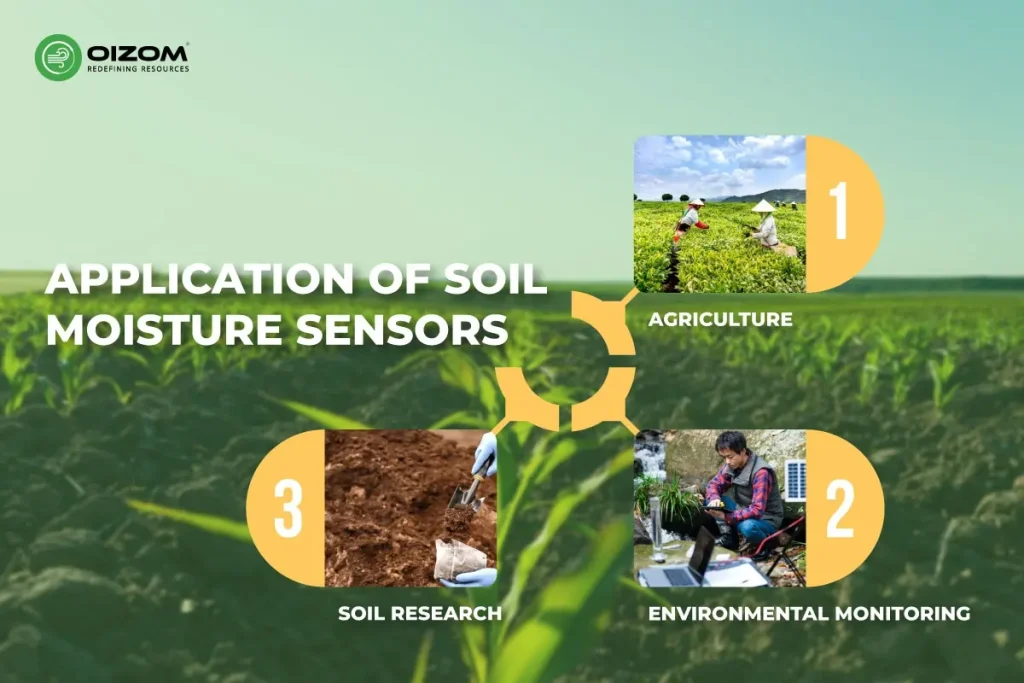10 key takeaway points:
- Purpose: Soil moisture sensors measure soil water content for efficient irrigation and resource management.
- Types: There are two main types: water potential sensors (e.g., tensiometers) and water content sensors (e.g., capacitance).
- Water Potential: Measures how hard it is for plants to extract water, ideal for precise irrigation.
- Water Content: Determines soil moisture levels using capacitance or time domain methods.
- Working Principle: Uses TDR or FDR technology for accurate soil moisture measurement.
- Installation: Sensors can be placed vertically for surface data or horizontally for deeper readings.
- Data Insights: High readings mean wet soil; low readings suggest irrigation is needed.
- Envizom Integration: Envizom and Weathercom offer real-time, easy soil moisture tracking.
- Applications: Useful in agriculture, environmental monitoring, and soil research.
- Advancements: Continual improvements make sensors more accurate and reliable for sustainable use.
What is a Soil Moisture Sensor? A Quick Guide
Have you ever wondered how farmers ensure their crops get just the right amount of water? Or how smart gardens seem to “know” when to turn on the sprinklers? That’s where soil moisture sensors come into play. These smart devices measure the water content in the soil, helping optimize irrigation and save water, and support farmers, gardeners, and researchers in managing irrigation more efficiently. Soil moisture sensors are vital in agriculture, environmental monitoring, and soil research.
They’re not just about convenience; they play a crucial role in sustainable practices, reducing water waste, and improving plant health. With modern technology, these sensors are more accessible and accurate than ever, making them an essential tool for anyone looking to keep their green spaces flourishing. Are you curious to learn more about how they work and why they’re so useful? Let’s dive in.
Types Of Soil Moisture Sensors
There are basically two groups of sensors:
- Water potential sensors, such as tensiometers and granular matrix sensors.
- Soil moisture sensors that give a percentage or relative content of soil moisture.
Water Potential Sensor: These sensors detect how difficult it is to remove water from the soil, giving the most accurate indicator of available water for plants. Soil type and water content influence the suction pressure required to remove water from the soil. Still, a monitoring sensor, which is recorded and graphed, will show a fast drop, indicating that water has become difficult for a plant to reach.
The two most common types of water potential sensors are tensiometers and granular matrix sensors, such as gypsum blocks and watermark sensors.
Water Content Sensors: These sensors determine the water content of soil by measuring the timing or frequency of a pulse traveling between or returning to electrodes. The most frequent categories are capacitance and time/frequency domain. Most sensors are accurate within 2-3% of soil moisture.
Capacitance sensors: Capacitance sensors typically measure numerous depths at intervals of 10 to 20 cm and range in length from 40 to 180 cm. Multiple depth measurements provide useful information on water transport across the soil profile and the relative moisture content of the soil at various depths.
The restriction of most capacitance sensors is that they only monitor a tiny volume of soil outside the sensor’s access tube or walls. Correct installation must maximize soil contact while preventing water from moving preferentially along the exterior of the sensor. If this happens, the measurements will not accurately reflect the situation in the undisturbed soil away from the sensor. The measurement method means that these sensors are impacted by salts in the soil: salts enhance electrical conductivity, causing the sensor to overestimate soil moisture.
Time and frequency domain sensors: True time domain reflectometry (TDR) sensors are extremely accurate but require complex and expensive measurement equipment. Sensors that use water content reflectometry (WCR) and temporal domain transmissometry (TDT) provide a comparable, less expensive option.
This sort of sensor typically consists of two or three metal prongs ranging in length from 5 to 30cm that are inserted into the side of a soil pit to measure the undisturbed soil. The measurement ranges from 3 to 6 cm around the sensor, resulting in a higher volume of soil recorded (0.3 to 8 L).
True time domain reflectometry (TDR) sensors are extremely accurate, but they require complex and expensive measurement equipment. Sensors that use water content reflectometry (WCR) and temporal domain transmissometry (TDT) provide a comparable, less expensive option.
This sort of sensor typically consists of two or three metal prongs ranging in length from 5 to 30cm that are inserted into the side of a soil pit to measure the undisturbed soil. The measurement ranges from 3 to 6 cm around the sensor, resulting in a higher volume of soil recorded (0.3 to 8 L).
How Soil Moisture Sensors Work
A soil moisture sensor is a device that measures the moisture content of soil, which is essential for agricultural irrigation, environmental monitoring, and scientific study. These sensors determine the moisture state of the soil using several technical principles, including TDR (Time Domain Reflectance) and FDR (Frequency Domain Reflectance), which are two common methodologies.
Installation and Maintenance of Soil Moisture Sensors
The soil moisture sensors can either be placed vertically for measuring moisture content on the topmost layer of the soil or horizontally if moisture needs to be measured at certain depths.
- Surface Measurement: If surface measurement needs to be done, the sensor should be inserted vertically into the soil. Make sure the sensor is not loosely inserted.
- Buried Measurement: To take measurements at depths, dig the pit of about 20 cm diameter till the desired depth and insert the sensor’s needles horizontally into the pit wall at the desired depth. Fill the pit tightly and allow the sensor to stabilize.
Ensure that:
- The steel needles must be inserted into the soil during the measurements.
- The sensor needle does not touch hard objects like stones or pebbles.
- Avoid Intense sunlight directly on the sensor for high temperatures. Use in the field to prevent lightning strikes.
- Due to the presence of radio-frequency electromagnetic radiation in the air, it is not suitable to keep the sensor open while powered on for a long time.
- If multiple sensors are to be used in the same site, ensure that the distance between each sensor is at least 20 cm.
Reading And Interpreting The Sensor Data
Reading and interpreting soil moisture sensor data is simpler than it sounds. Most sensors display readings as percentages or voltage levels, representing the water content in the soil. The key is understanding what these numbers mean for your application.
For example, a high moisture reading indicates wet soil, which may not require watering. On the other hand, a low reading signals dry soil, suggesting it’s time to irrigate. Many modern sensors come with user-friendly apps or displays that convert these readings into actionable insights, such as “Water Now” alerts.
It’s also important to consider the soil type and crop needs. Sandy soil may need more frequent watering than clay, even if the sensor readings are similar. Regularly monitoring the data helps you spot patterns, optimize water use, and maintain healthy soil conditions.

Envizom provides instant insights into soil moisture levels, making it easier to plan irrigation, monitor environmental conditions, or conduct research. With Weathercom and Envizom together, you get a simple yet powerful solution to handle weather and soil data without any hassle.
Application of soil moisture sensors

- Agriculture: Soil moisture sensors help farmers track soil water levels, plan irrigation schedules wisely, and use water resources efficiently. This ensures crops grow healthier and boosts overall productivity.
- Environmental Monitoring: These sensors provide real-time soil moisture data, aiding soil quality assessment, disaster prediction, and climate change studies.
- Soil Research: In soil science, they offer reliable data to understand soil properties, diagnose issues, and evaluate soil health effectively.
Conclusion
In conclusion, soil moisture sensors play a crucial role in understanding and managing soil conditions. By measuring the soil’s water content, they empower fields like agriculture, horticulture, soil science, and environmental studies to optimize productivity and resource use.
These sensors offer real-time data to improve irrigation, prevent natural disasters, and protect the environment. As technology advances, soil moisture sensors continue to evolve, providing even more accurate and reliable insights for sustainable practices and innovative research.






